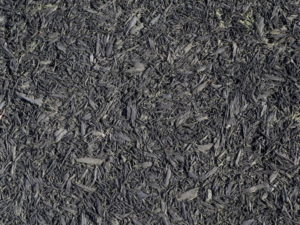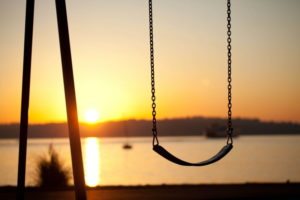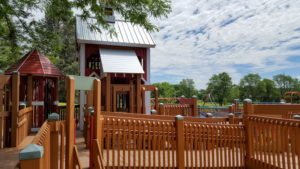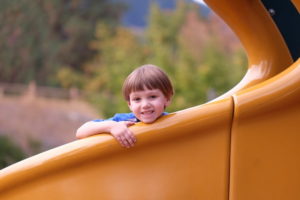Should You Choose Natural Surface for Your Playground?
It may seem like the ground surface options for your playground area are endless, with options ranging from natural grass and dirt to poured-in place (PIP) rubber. Each option has its own maintenance needs, expected longevity, accessibility ratings, and installation requirements. Naturally, we think your best option is poured-in-place surfacing. Still, we also place great value in making a well-informed decision. That’s why we created this thorough review of natural grass, examining the pros and the cons.
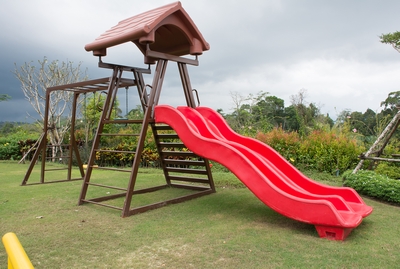
Natural Grass or Dirt for Playground Surfacing
Note that in this post, we’re not talking about artificial grass for playgrounds. Natural grass (example: rolls of sod) and playground dirt are exactly what you imagine them to be. Now you might be wondering why someone would use grass for a playground or dirt. Sometimes it comes down to cost or whether it’s for a backyard or school playground.
What type of grass is used for playgrounds? In addition to artificial grass, two of the most popular options are spreading grass seed or using pre-grown sod (it’s grown by farmers and then cut in rows and sold as rolls of sod). Other than parking lots/driveways, most space around buildings is already made up of natural grass, so the easiest option is to not care about playground ground cover at all. But is that the best option?
Safety and Accessibility of Natural Grass for Playgrounds
Pros:
- Using natural grass and dirt has a significant benefit of cooler and softer surfaces. Natural grass reduces heat island effects in urban and suburban areas, which some other playground surface types can cause.
- Certain artificial surfaces can reach temperatures 50-60 degrees above natural grass. Its lower temperatures lead to less risk of skin burns or other injuries often associated with harder, chemical-based playing surfaces.
- Playground ground surfaces with natural turf or grass can also serve as a buffer to their communities. The grass can act as a filter to trap harmful pollutants in its dense root system and capture contaminants before they end up in groundwater systems.
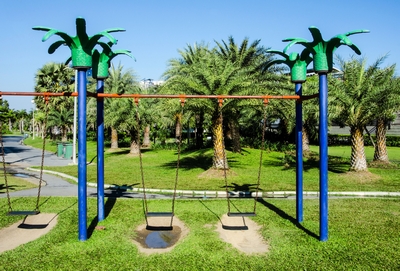
Cons:
- The Consumer Product Safety Commission (CPSC) says that dirt and grass are “inappropriate surfacing” types for playgrounds.
- While grass looks nice at first, it quickly becomes worn out and can have uneven spots, increasing the risk of tripping.
- Natural grass may be soft enough for a picnic, but it’s not ideal for landing when you jump from a swing. Playground grass doesn’t provide as much impact absorption compared to other surfaces, meaning children can get seriously injured if they fall. You can’t manipulate the thickness or add underlayment to meet fall height safety regulations with natural grass.
- Takes longer to dry than most artificial surfaces. The kiddos will have to wait until the puddled water dries up before playing.
- ASTM, the American Society for Testing and Materials, has even considered marking natural grass as unsafe for playgrounds.
- Some studies state well-maintained grass with about six inches of subsoil may be a suitable surface for falls up to six feet. However, dry or freezing weather will make the surface significantly harder, negatively affecting the impact level.
- Playground grass also isn’t easy on wheelchairs, unlike other surfaces such as playground rubber tiles. The high friction surface of grass requires a lot of effort to push, making it less than ideal for an Americans with Disabilities Act (ADA) compliant, accessible playground.
- It’s also prone to pests and can be a haven for allergy-causing weeds and bacterial buildup.
Cost of Natural Grass for Playground Flooring
Pros:
- The best part about natural grass is that it won’t cost much to repair. As long as you replace grass in smaller patches, it’ll cost $0.50 per square foot for seed or $2 per square foot for sod (though to get that price for sod, you’ll likely have to buy more than 1 square foot).
- If you need to replace the whole playground area, check out the installation’s total cost below. Your playground grass can also earn you LEED points for heat island reduction.
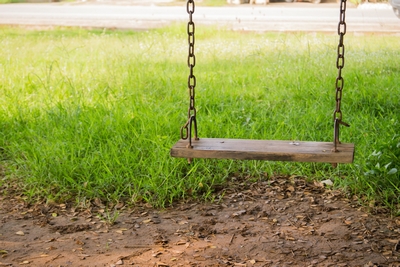
Cons:
- Before you install your grass, you’ll need to consider irrigation. An irrigation system or sprinkler system can cost an average of $2 per square foot, equating to $2,000 for 1,000 square feet of grass.
- While easier to install since sod is pre-grown, the sod comes with a higher price tag, starting at $3.50 per square foot with a professional installer. A 1,000 square foot residential playground grass area with sod installation could cost $3,500 or $5,500 with irrigation.
- In comparison, a commercial playground area of 5,000 square feet with natural grass or sod could cost $17,500 or $27,000 with irrigation. The more affordable option of seeding natural grass will cost about $0.05 per square foot if you do it yourself, or $50 for a 1,000 square foot area.
- You’ll need to thoroughly water the seed for the first eight weeks for it to grow correctly, creating an additional cost for irrigation.
Quality and Maintenance of Grass Playground Surfaces
Pros:
- Natural grass is very heat tolerant, with it often 50 to 60 degrees cooler than surrounding artificial surfaces.
- It initially looks very aesthetically-pleasing.
- When it comes to repairing problem areas in your playground grass, in most cases, you can fill in bare spots with seed, or in the case of St. Augustine grass, you can add sod or plugs.
- There may be more benefits to natural grass and soil in the future due to ongoing research to create improved grass types, called cultivars, for playgrounds and public parks.
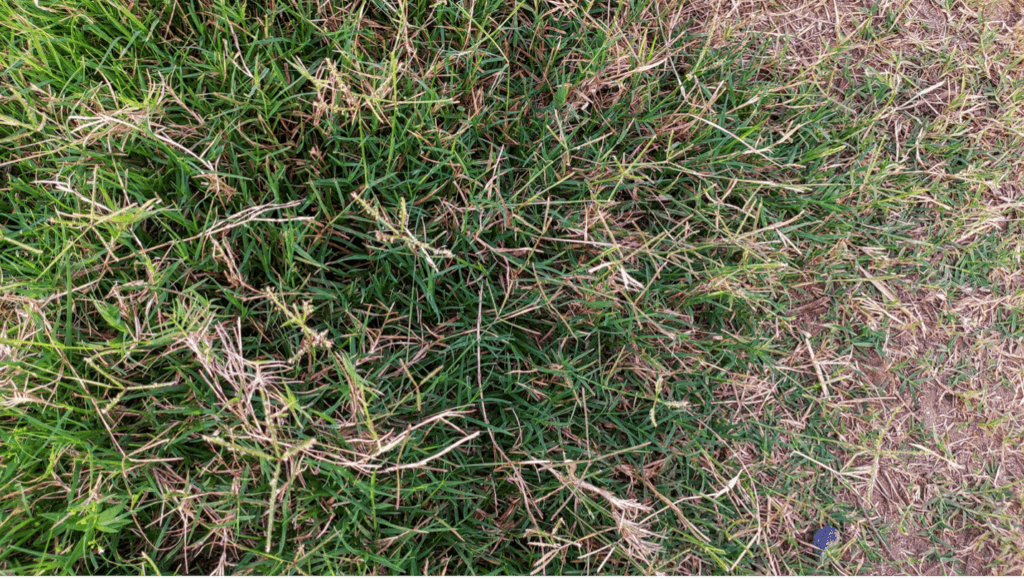
Cons:
- Natural grass is one of the highest maintenance options when it comes to playground surfaces. Expect to blow or rake leaves off the grass in the fall and mow the grass weekly.
- Other maintenance tasks may include: mowing, edging, fertilizing, weeding, watering, and more. If you’re using playground dirt, you’ll have to refill it quite often compared to some other playground surface types (like poured rubber surfacing or rubber tiles).
- Depending on the weather conditions and use, grass can die, scorch, or become muddy.
- No grass is frost resistant, but whether frost harms your grass or not depends on the grass species. Some grasses can handle frost better than others.
- Natural grass can also be a drain on fossil fuels, often requiring fertilizers, pesticides to avoid weed growth, as well as fuel to mow the grass.
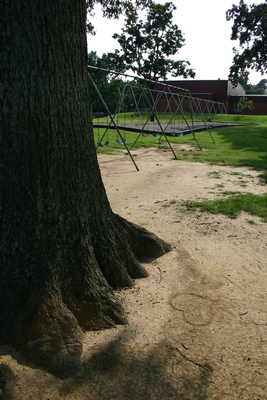
Installation of Natural Grass and Playground Soil Surfacing
Pros:
- Natural grass is sometimes already in the area where you’re building the new playground.
- You can plant natural grass by seeding the area or laying down sod.
- You can easily plant grass seeds yourself but bring in a professional if you choose sod over grass seed.
- You can find sod and grass seed at any hardware store, or if you prefer, you can call your favorite landscape professionals.
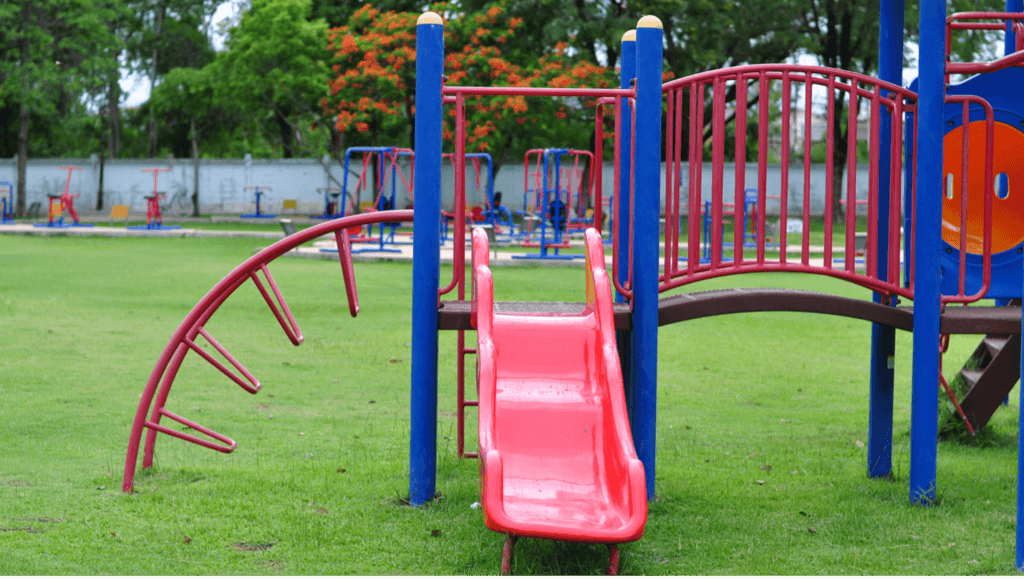
Cons:
- Installation is not as simple as it first appears. Done properly, both natural grass and playground soil should have proper irrigation and ground prep.
- First, consider installing a new irrigation system and drainage to avoid mud. From there, the steps are about the same for seed and sod installation. Remove stones, roots, and other debris to create a smooth surface.
- Next, rake the surface until it falls below the desired grade and then install edging. Add a good topsoil base, grade the surface, and add lime for a more alkaline pH.
- Finally, you can lay rows of sod or spread the seed over the prepared area. For seed, you’ll need to rake the soil to ensure the seed comes in contact with the ground and topdress with a layer of straw to aid germination. For both seed and sod, water three times a day for the first two weeks. Sod will need some starter fertilizer to ensure the grass has the proper nutrients. Using seed will require you to stay off the surface for the first two months until roots are thoroughly established.
- The installation process will likely take a day or two, mainly doing the site prep, but it all depends on the size of your playground surface.
Alternative Playground Surfaces
Even though natural grass is aesthetically pleasing, it’s typically not the best for commercial playground surfacing. When it comes to ensuring the children on your playground have a safe place to play, you want to be sure the surfacing is a top priority. The surface should provide a comfortable, soft cushion to walk on and, when installed correctly, should be compliant with ADA standards for handicap accessible playgrounds.
Looking for an alternative? Get a free quote today for premium poured-in-place rubber surfacing or rubber playground tiles made to keep your playground safe, fun, and enjoyable for everyone.
With so many different qualities and characteristics to consider, choosing a playground surface can be bewildering. That’s why we’ve created an ultimate guide of all the pros and cons of 11 of the most popular playground surfaces, from wood chips to recycled rubber mulch.
FAQs About Using Natural Grass/Dirt for Playgrounds
There’s multiple reasons why we don’t recommend using natural grass or playground soil, including not having the cushion that artificial playground surfaces can have.
Additionally, the American Society for Testing and Materials, has considered marking natural grass as unsafe for playgrounds.
Short answer: a lot. Natural grass is one of the highest maintenance playground surfacing options, even though it might appear to be the cheapest upfront cost. Not to mention that if you don’t replace the grass, the worn out patches will simply be dirt and turn into mud when it rains or snows.
Installing natural grass as playground surfacing:
- Plant grass seed and wait.
- Buy pre-grown grass rolls (sod rolls).
Installing playground dirt/soil:
- Buy bags of it from a hardware store. You’ll probably need to have it delivered. You’ll then need to spread it out over the playground area.
- Pay a laborer to install it for you.
